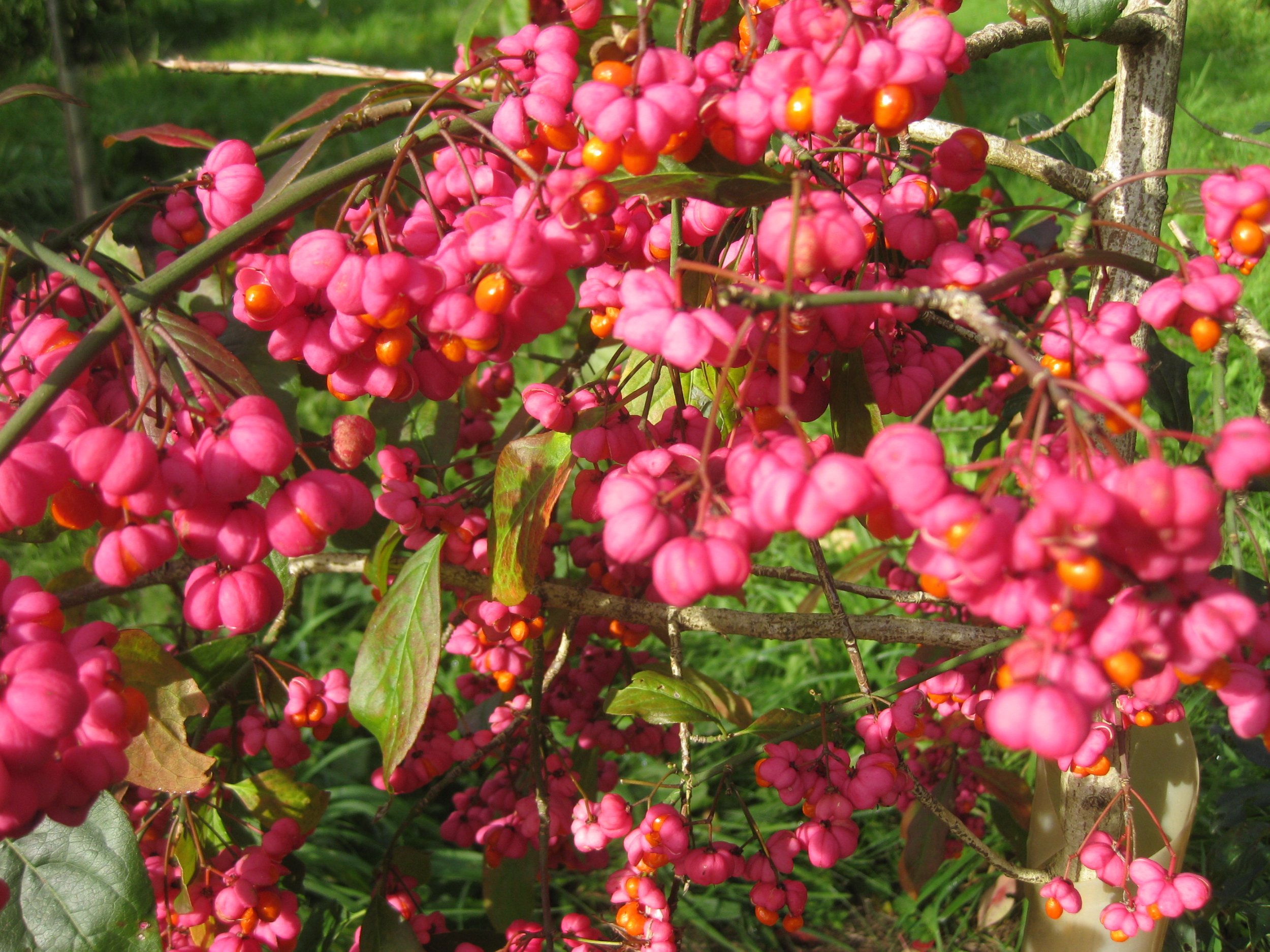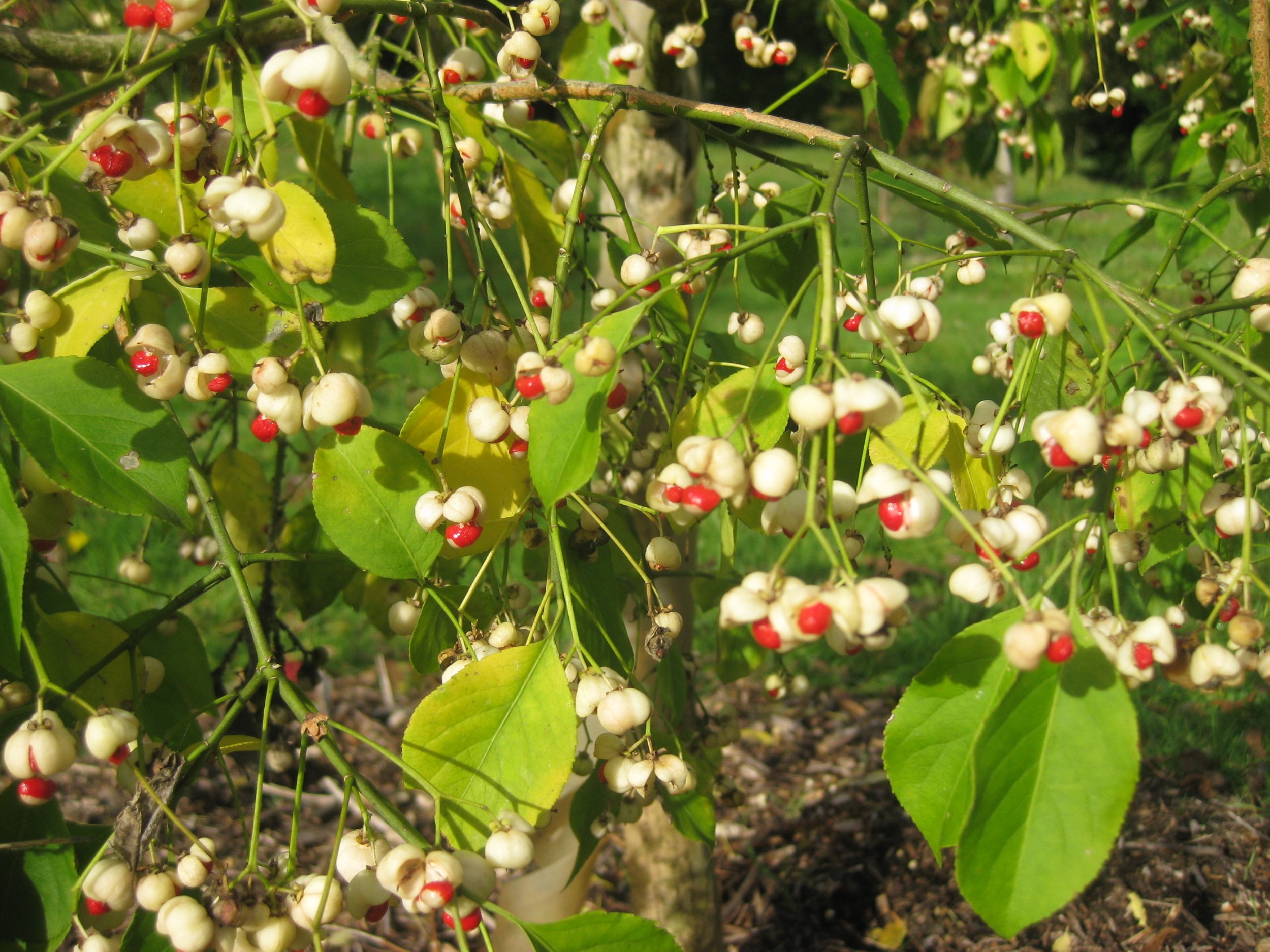Autumn 2021 Spindle
Euonymus europaeus is one of our few native shrubs. In autumn it looks dramatic with its brightly coloured leaves and vivid, lobed fruits with bright orange seeds. It can be grown as a hedge plant or as a small tree. Wildlife will appreciate its insignificant green flowers as they attract aphids and their predators such as hoverflies, ladybirds and lacewings. Bees love them too. In June you might have seen hedges of it enshrouded in webbing which gives them an unseasonal Halloween look. This is caused by the beautiful Ermine Moth which creates nurseries of web for its caterpillars (pictured below right). This little moth is white with black spots. Although the leaves are stripped by hungry caterpillars this doesn’t seem to cause permanent harm to the bushes. In autumn birds love the seeds which are poisonous to humans.
As with all native plants, myths and superstitions have become part of its story. The name Euonymus comes from the Greek; ‘eu’ means lucky and ‘onama’ is Greek for name. I don’t know why it was called lucky because in some areas if it flowered early then plague was supposed to be on the way. But the wood which is hard and dense was useful for spindles and hence its name. It was also useful for tooth picks and knitting needles. The toxic berries were ground to treat head lice, or alarmingly as a laxative. Today, the wood is still used to make excellent artist’s charcoal.
There are plenty of spindles to choose from with gorgeous fruits and many of them have fabulous autumn colour too. If you like the idea of growing varieties of our native Euonymus europaeus, then ‘Red Cascade’ or ‘Thornhayes’ (pictured left and top) are good choices; they are both lovely with masses of fruit and bright red autumn foliage.
But there are many other varieties from other parts of the world which are just as eye-catching. Some of them have red berries, others are pink or white. I love Euonymus cornutus var.quinquecornutus which comes from China. Its pink berries have curious horns which make them look just like jesters’ hats. The berries are orange. Or another ‘Jester’s Hat’ variety is Euonymus clivicola var. rongchuensis (pictrured right) which comes from Nepal and Bhutan. This is an elegant shrub with narrow leaves.
Euonymus oxyphyllus ‘Angyo Elegant’ (pictured left) the Korean euonymus is just as striking but with long stalked, dangling fruit like Edwardian ear rings. The autumn leaves turn reddish purple.
Euonymus hamiltonianus comes from Asia and is sometimes known as the Himalayan spindle. There are several beautiful cultivars of this variety; one of my favourites is ‘Koi Boy’ (pictured right) which has white fruits with bright red seeds which are supposed to look like Koi carp because of their striking colour .The leaves turn butter-yellow in autumn.
Similar to ‘Koi Boy’ is Euonymus hamiltonianus Pop Corn.’ (pictured left)
I love all the varieties of Euonymus hamiltonianus, but if I had to choose just one it would probably be ‘Miss Pinkie’ (pictured right) because it is compact and has yellow autumn leaves and masses of pale pink fruit with bright red seeds.
But then I really covet a variety of the flat-stalked Euonymus planipes which comes from Japan. The one I would go for is a Dutch selection called ‘Sancho’ (pictured left); this one looks as if it is dressed for the carnival with showy fruit and lovely, bright red leaves.
Many varieties of euonymus have striking autumn leaves but I think the winged euonymus, Euonymus alatus ‘Rudy Haag’ (pictured right) is probably the most vibrant. It’s sometimes known as the Burning Bush and it certainly lives up to its name. You don’t need Acers when you have this beauty lighting up your garden.
If you would like to see a range of spindle trees in all their vibrant autumn dress then we are lucky here in Suffolk. Rupert Ely at The Place for Plants, East Bergholt has the National Collection. Now is the time to go and admire them.
Liz Wells - EAGG Member










